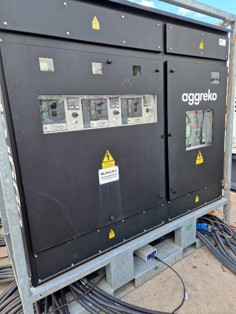
Mythbuster #10 “Event distribution boards with socket-outlets are not permitted for use on construction sites”
The concern is that distribution boards which are fitted with connectors (exampled in Figure 1) are not as suitable for use in a typical construction environment, unlike typical steel framed boards to which incoming and outgoing circuits are manually terminated (as illustrated in Figure 2).
Figure 1 Distribution board fitted with plug and socket connectors

Figure 2 Rewireable metal-cased distribution unit

Many rental companies are moving over to preassembled extension leads and distribution boards as the equipment can be reused time and again without waste. It also saves time on-site, allowing functional systems to be erected and commissioned quickly using pre-terminated and pre-tested equipment.
There are three standards of relevance for this application. Firstly, BS 7671 Requirements for Electrical Installations has, in addition to the general rules, additional requirements for construction and demolition sites in Section 704. The second standard is BS EN 61439 Low-voltage switchgear and controlgear assemblies and particularly Part 4 of that standard, BS EN 61439-4 Low-voltage switchgear and controlgear assemblies. Particular requirements for assemblies for construction sites (ACS). The final one is BS 7375 Distribution of electricity on construction and demolition sites. Code of practice.
As always, it pays to start at the beginning to trace the requirements. Part 1 of BS 7671 (Scope, Object and Fundamental Principles) requires the designer to consider the environmental conditions to which the electrical installation will be subjected to (Regulation 132.5.1) and equipment should be selected, taking into consideration the conditions of the installation (Regulation 133.3), and to ensure that equipment complies with appropriate standards (Regulation 133.1).
Moving through BS 7671, Regulations 511 and 512.2 reinforce the requirements for compliance with standards and equipment selection according to external influences respectively. Notably, Regulation 512.2.2 does state that:
If the equipment does not, by its construction, have the characteristics relevant to the external influences of the location, it may nevertheless be used on condition that it is provided with appropriate additional protection in the erection of the installation.
These requirements are expanded on in Section 704. In respect of Regulation 511, Regulation 704.511.1 details which standards as follows:
All assemblies on construction and demolition sites for the distribution of electricity shall be in compliance with the requirements of BS EN 61439-4. Plugs and socket-outlets with a rated current of 16 A up to 125 A shall comply with the requirements of BS EN 60309-2. Plugs and socket-outlets with a rated current exceeding 125 A up to 800 A and where interchangeability is not required shall comply with BS EN 60309-1.
Regulation 704.512.2 expands on the types of environmental factors to which equipment may be subject as follows:
Consideration shall be given to the risk of damage to electrical equipment by corrosive substances, movement of structures and vehicles, wear and tear, tension, flexing, impact, abrasion, severing and ingress of liquids or solids.
Note that Regulation 704.511.1 refers to BS EN 60309-2 connectors (‘Commando’ or ‘Ceeform’ types) which is of course a characteristic of the distribution boards shown in Figure 1. Regulation group 704.522.8 goes on to state requirements for cable, noting that H07-RNF types should be used for low voltage supplies which are commonly used with BS EN 60309 connectors in this application. The common single-pole connectors used for supplies over 125 A (often referred to by the brand name ‘powerlock’) are also catered for in Regulation 704.511.1.
With these requirements in mind, it can be seen that BS 7671 does not preclude the use of such distribution boards if they comply with BS EN 61439-4 and where connections are made by plug and socket, that the connections use BS EN 60309-2 connectors as depicted in Figure 1.
In respect of compliance with standards, distribution boards should be manufactured to BS EN 61439-1 and additional specific requirements for assemblies for construction sites (ACS) are given in BS EN 61439-4. This has requirements for service conditions such as ambient air temperatures, humidity and pollution levels. Part 4 also has specific requirements for labelling, handles, accessible parts and terminals for external conductors. Notably, this has requirements for terminals for external conductors, stating “All connections shall be rewireable or shall be socket-outlets.”
Assuming the distribution unit is constructed to comply with Part 1 of BS EN 61439, suitably IP rated and complies with the additional mechanical, impact and corrosion requirements of Part 4, there are no particular requirements that would preclude the use of the distribution boards exampled in Figure 1.
Finally, there is the Code of Practice for Distribution of electricity on construction and demolition sites, BS 7375. The current version is dated 2010 and is in need of revision in places, not least to review the out-of-date references. As well as general requirements for robustness, it does state inter alia that:
Distribution equipment in site installations should embody the following features: a) flexibility in application for repeated use on contract work, i.e. to allow easy substitution of components for specific duty as might be required from site to site; b) suitability for transport and storage.
The distribution boards examples in Figure 1 fulfill both these requirements admirably. They have long been in used in events and entertainment where such portability and robustness are key factors as they are often used in different locations on a daily basis and in quite arduous conditions.
Assuming a distribution board complies with BS EN 61439, there is no reason why it cannot be used on construction sites whether fitted with connectors or other terminations. Even if the mechanical or IP rating requirements cannot be complied with, BS 7671 does allow for additional measures to be put in place to achieve an equivalent level of protection.
